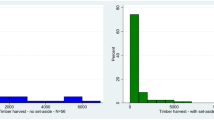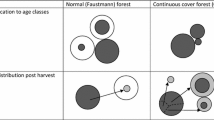Abstract
The paper studies optimal forest taxation under uncertainty about future timber price when private forest owners value amenity services of forest stands and forest stands have public goods characteristics. It is assumed that preferences of forest owners can be described by a quasi-linear, intertemporal utility function which reflects risk aversion in terms of consumption and constant marginal utility in terms of amenity services. The comparative statics of current and future harvesting in terms of timber price risk, site productivity tax and yield tax are first developed. It is shown that, given the optimal site productivity tax, which is independent of the timber harvested and thus non-distortionary, it is desirable to introduce the yield tax at the margin; it both corrects externality due to the public goods characteristic of forest stands and serves as a social insurance device. The optimal yield tax is less than 100% and depends on the social value of forest stands, timber price risk and properties of compensated timber supply. In the general case the 'inverse elasticity rule’ – according to which the optimal yield tax is negatively related to the size of the substitution effects – may not hold. Under certainty, the desirability of the yield tax, given the optimal site productivity tax, depends only on the existence of public goods characteristic and is thus a pure Pigouvian tax.
Similar content being viewed by others
References
Atkinson, A. B. and J. E. Stiglitz (1980), Lectures on Public Economics. Singapore: McGraw Hill.
Basar, T. and G. Olsder (1982), Dynamic Non-Cooperative Game Theory. London: Academic Press.
Binkley, C. S. (1981), Timber Supply from Private Nonindustrial Forests. Yale University, School of Forestry and Environmental Studies, Bulletin No. 92.
Bowes, M. D. and J. V. Krutilla (1989), Multiple-Use Management: The Economics of Public Forests. Washington D.C.: Resources for the Future.
Calish, S., R. D. Fight, and D. E. Teeguarden (1978), 'How Do Nontimber Values Affect Douglas-Fir Rotations', Journal of Forestry 76, 217-221.
Diamond, P. A. and M. Yaari (1972), 'Implications of the Theory of Rationing for Consumer Choice Under Uncertainty', American Economic Review, 333-343.
Englin, J. E. and M. S. Klan (1990), 'Optimal Taxation: Timber and Externalities', Journal of Environmental Economics and Management 18, 263-275.
Hartman, R. (1976), 'The Harvesting Decision When A Standing Forest Has Value', Economic Inquiry 14, 52-58.
Hirschleifer, J. and J. G. Riley (1992), The Analytics of Uncertainty and Information. Cambridge: Cambridge University Press.
Hyberg, B. T. and D. M. Holthausen (1989), 'The Behavior of Nonindustrial Private Forest Land-owners', the Canadian Journal of Forest Research 19, 1014-1023.
Knapp, G. P. (1981), The Supply of Timber from Nonindustrial Private Forests. Yale University, Dissertation.
Koskela, E. (1984), 'On the Effects of Differentiated Income Taxation on Portfolio Selection', Economic Letters 16, 145-150.
Koskela, E. (1989a), 'Forest Taxation and Timber Supply Under Price Uncertainty: Perfect Capital Markets', Forest Science 35, 137-159.
Koskela, E. (1989b), 'Forest Taxation and Timber Supply Under Price Uncertainty: Credit Rationing in Capital Markets', Forest Science 35, 160-172.
Mas-Colell, A., M. D. Whinston, and J. R. Green (1995), Microeconomic Theory. Oxford: Oxford University Press.
Max, W. and D. E. Lehman (1988), 'A Behavioral Model of Timber Supply, Journal of Environmental Economics and Management 15, 71-86.
Montgomery, C. A. and D. M. Adams (1995), 'Optimal Timber Management Policies', in D. W. Bromley, ed., The Handbook of Environmental Economics. Cambridge, MA and Oxford: Basil Blackwell.
Ollikainen, M. (1993), 'A Mean-Variance Approach to Short-Term Timber Selling and Forest Taxation Under Multiple Sources of Uncertainty', the Canadian Journal of Forest Research 20, 1823-1829.
Ovaskainen, V. (1992), 'Forest Taxation, Timber Supply, and Economic Efficiency', Acta Forestalia Fennica 233.
Persson, T. and G. Tabellini (1990), 'Macroeconomic Policy, Credibility and Politics. New York: Harwood Academic Publishers.
Sandmo, A. (1976), 'Direct Versus Indirect Pigouvian Taxation', European Economic Review, 337-349.
Snyder, D. L. and R. N. Bhattacharyya (1990), 'A More General Dynamic Economic Model', Journal of Environmental Economics and Management 18, 168-175.
Strang, W. J. (1983), 'On the Optimal Forest Harvesting Decision', Economic Inquiry 21, 576-583.
Swallow, S. K. and D. N. Wear (1993), 'Spatial Interactions in Multiple-Use Forestry and Substitution and Wealth Effects for the Single Stand', Journal of Environmental Economics and Management 25, 103-120.
Varian, H. R. (1980), 'Redistributive Taxation as Social Insurance', Journal of Public Economics 14, 49-68.
Varian, H. R. (1993), Microeconomic Analysis. 3rd edition. New York: W. W. Norton and Company.
Vincent, J. F. and C. S. Binkley (1993), 'Efficient Multiple-Use Forestry May Require Land-Use Specialization, Land Economics 69, 370-376.
Tilli, T. and J. Uusivuori (1994), 'Short-Term Timber Price Variations in Finland During 1985-91 and 1991-93. Pellervo Economic Research Institute, Reports and Discussion Papers, No. 132 (in Finnish with an English summary).
Author information
Authors and Affiliations
Rights and permissions
About this article
Cite this article
Koskela, E., Ollikainen, M. Optimal Design of Forest Taxation with Multiple-Use Characteristics of Forest Stands. Environmental and Resource Economics 10, 41–62 (1997). https://doi.org/10.1023/A:1026472622826
Issue Date:
DOI: https://doi.org/10.1023/A:1026472622826




